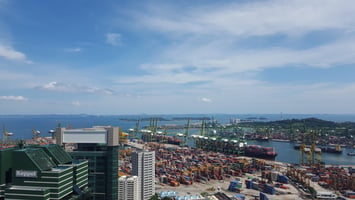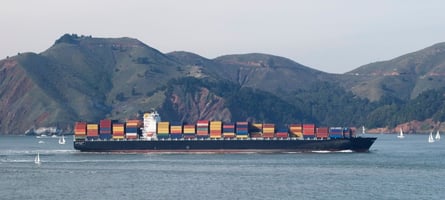As a result of the recent US-China Trade War and the ensuing economic uncertainties, more and more...
Best Countries for Outsourcing your Manufacturing
In a previous blog article, we explored the opportunities of outsourcing manufacturing in Southeast Asia for the increasingly large number of US companies who consider to diversify part of their manufacturing away from China. In this article, we will be exploring the different benefits and detriments present in outsourcing manufacturing to Central and Eastern Europe, Brazil, Mexico, and India - regions and countries outside of Southeast Asia popular among companies looking to outsource their manufacturing.
Central and Eastern Europe
Since the end of Soviet occupation in the 1990s and the shift to market-based economies, Central and Eastern European countries’ manufacturing sectors have flourished thanks to a large inflow of FDI from Western European states looking to offshore production (while minimising transportation costs). As a result, a 2019 report by the Institute of Labor Economics found that ‘By 2017 the average contribution of manufacturing to these 8 countries’ GDP wasat 20 percent higher than the EU average of 15 percent.’
Additionally, Central and Eastern Europe has arguably become the main automotive hub of the region, with the Hyundai plant in the Czech Republic alone producing 350,000 cars a year notwithstanding the Volkswagen factory in Poland. Recently, Poland has also grown to be the fifth largest global supplier and Europe’s leading supplier of lithium-ion batteries, according to a 2021 article by Politico.
Moreover, to quote the 2019 report by the Institute of Labor Economics, ‘Between 2009 and 2014 they found that employment in transport equipment manufacturing in Hungary increased by 19 percent and in machinery and equipment by 6 percent, while it declined in textile manufacturing by 4 percent’. This shift in Hungary is arguably reflective of a larger regional shift from labour-intensive, basic goods manufacturing common during the Soviet era to the more capital-intensive manufacturing following Central and Eastern Europe’s ascension to the European Union (EU)
Following the downfall of the Soviet Bloc and the shift to a more open market-based economy, many Central and Eastern European industries initially suffered due to an inability to compete with foreign, western companies entering the market. However, Central and Eastern European countries were able to ultimately turn this around, especially in the manufacturing industry, by making the most of incoming FDI and technology transfers between Western and Central and Eastern European companies, which are both a result of greater cooperation with the EU and especially Germany.
Since joining the EU (the Czech Republic, Lithuania, Poland, Hungary, Slovenia, and Slovakia joining in 2004; Bulgaria and Romania in 2007), Central and Eastern European countries have enjoyed numerous benefits aside from greater political stability, with all Central and Eastern European countries ranking between 8th (Czech Republic) and 36th (Lithuania) on the 2020 Global Peace Index.
For example, Central and Eastern European countries have received billions from the EU Structural Funds - aid provided by the EU to former socialist states to improve their infrastructure, allowing countries to significantly improve upon their logistics, infrastructure, and international shipment capabilities. The Czech Republic, in fact, was ranked 10th globally on the 2018 Logistics Performance Index (LPI), whereas Poland was ranked 12th, Estonia 39th, Bulgaria 41st, Hungary 47th, and Slovakia 53rd.
Furthermore, as EU Member States, these countries are party to numerous EU Free Trade Agreements (FTAs) which include: the EU-Japan FTA, the EU-Singapore FTA, the EU-Korea FTA, the EU-Mexico FTA. The EU is also currently undergoing negotiations with China, India, and Indonesia in regards to a future FTA. There is no doubt that these future FTAs can offer significant benefits to signatory states and transform the future of the global economy.
As labour costs continue to rise in the region and Asian markets continue to become more and more attractive, Central and Eastern European states must make the most of Industry 4.0 technologies so as to maintain the current growth of the manufacturing sector and to prevent foreign companies from reshoring. Central and Eastern European countries are arguably poised to benefit greatly from these technologies, in addition to transitioning more smoothly to these technologies, due to the large number of high-skilled workers within the labour force (high-skilled workers make up between 32%-43% of the labour force depending on the specific country according to the 2017 World Economic Forum Global Human Capital Report).
Likewise, Central and Eastern European states must also continue to utilise the different incentives implemented to promote greater investment in and to encourage companies to base production in Central and Eastern Europe. Among these incentives are Slovakia’s investment aid - which can be used by companies involved in industrial production for land and building acquisitions, new equipment and tech purchases, IP protection, etc. - and the Czech Republic’s corporate tax relief programmes and job creation and training and retraining grants for new companies expanding production within the country.
Brazil
According to the World Bank in 2019, Brazil has the 13th most valuable manufacturing sector globally in terms of manufacturing added value and the third largest manufacturing sector in the Americas behind the US (2nd) and Mexico (12th).
Additionally, PwC and Global Manufacturing and Industrialisation Summit (GMIS) report that in 2017 Brazil’s significant automotive industry exported a total of USD 14.7 billion worth of vehicles. Brazil’s aerospace industry, on the other hand, as one of only five countries in the world to manufacture commercial jets, reportedly exported USD 4 billion worth of aircraft, spacecraft, and parts in 2017. Brazil, as the 5th largest net steel exporter, also exported steel to over 100 countries worldwide in 2016.
With a history of military takeovers, it comes as no surprise that there have been concerns about democratic backsliding in Brazil amongst human rights CSOs such as Civicus, with frequent spats between the Brazilian President and the Supreme Court, kerbs on freedom of speech through a new ‘Fake News Bill’, and the distortion of Covid-19 data. To add to this, The New York Times also reports that the current President faces numerous criminal and legislative investigations over his relations and his family’s relations to online disinformation networks during the 2018 election and during his time in office. As such, it comes as no surprise that Brazil currently falls under the ‘Elevated Warning’ category of the 2020 Fragile States Index, alongside Russia and India.
According to the 2017 WEF Global Human Capital Report, 22% of the labour force are high-skilled and have a tertiary education, whereas 84.4% of the labour force are medium-skilled and have a secondary education. The same report also states that the Mean monthly earnings in Brazil are equivalent to USD 926. The mean monthly earnings for high-skilled workers, however, stand at USD 1,784, USD 700 for medium-skilled workers, and USD 485 for low-skilled workers.
As a member state of MERCOSUR (Southern Common Market), Brazil has an FTA with fellow members Argentina, Paraguay, and Uruguay. MERCOSUR also has FTAs with Israel, Egypt, Palestine, Lebanon, and is currently in the process of finalising a MERCOSUR-EU FTA which both parties have agreed to in June of 2020.
In terms of logistics, Brazil has an overall ranking of 56th on the 2018 LPI (behind Saudi Arabia and ahead of Rwanda), in addition to an infrastructure ranking of 50th (behind Latvia and ahead of Romania) and an international shipments ranking of 61st (behind Burkina Faso and ahead of Equatorial Guinea).
However, a 2021 article in the Financial Times regarding Ford shutting down a major plant in Brazil raises concerns about the future of the country’s automotive industry and the larger manufacturing sector as a whole. Ford’s exit is also arguably indicative of the failures of the Brazilian corporate tax system, the significant bureaucratic costs associated with running a business in the country, and a lack of proper backing and investment by the Government.
Mexico
The US International Trade Administration attributes Mexico’s current manufacturing success to the Maquiladora Export Program from the 1960s. Prior to the launch of the Maquiladora Export Program, the Bracero Program allowed Mexican labourers to seasonally enter the US and work as agricultural labourers. However, the program was ultimately scrapped by the US. Facing rising unemployment along the US-Mexican border, the Mexican Government enacted the Maquiladora Export Program. Under the program, companies in Mexico who base their operations along the US-Mexican border would be allowed to import parts or materials without paying for the hefty import duties so long as those parts or goods went into producing goods that would be exported.
Since the 1960s, Mexico has become a significant manufacturing power. According to a 2011 PR Newswire Article, the country is currently the second largest supplier of electronic products to the U.S. market. In terms of employment generation and export potential, the electronics manufacturing industry - which focuses on the manufacturing of audio and video devices, telecommunications and computer equipment and its parts - is one of the fastest growing in the country alongside the aerospace sector. The aerospace sector, on the other, hand, grew from 100 manufacturing firms and organizations in 2004 to 360 by mid-2019, according to the US International Trade Administration.
It can thus be argued that Mexico is a more politically stable yet more expensive alternative to Brazil, mainly in that both countries are significant automotive, electrics, and aerospace manufacturers. Mexico falls under the ‘Warning’ category of the 2020 Fragile States Index, being ranked 98th as opposed to Brazil’s 75th (under the Fragile States Index, a higher ranking such as Brazil’s 75th is indicative of greater political instability). However, as previously stated, it is likely that Mexico would be a more expensive destination as evidenced by the increase in minimum wage by 16% in 2018 (when compared to 2017) according to Reuters.
This increase in the minimum wage was initiated by President Lopez Obrador in part due to minimum wage increases in the past, in addition to being a means to ensure the high-skilled workers stay in Mexico and do not leave the country. In fact, according to the Oxford Business Group, between 2008-2012, President Felipe Calderon - who sought to make Mexico into a country of engineers - helped tripled the number of engineering graduates to 71,300 while at the same time inaugurating 120 new science- and engineering-oriented higher education institutions. As such, Mexico has a relatively high share of high-skilled workers in the labour force at 18.9% according to the 2017 WEF Global Human Capital Report.
In addition to thriving manufacturing industries, relative political stability, and a well-educated labour force, Mexico is party to numerous significant FTAs including the Comprehensive and Progressive Agreement for Trans-Pacific Partnership (CPTPP) alongside Australia, Brunei, Canada, Chile, Japan, Malaysia, New Zealand, Peru, Singapore, and Vietnam. Mexico is also party to the United States-Mexico-Canada Agreement (USMCA), the Mexico-EU FTA, the Mexico-Chile FTA, and the Mexico-Colombia FTA, among others.
Moreover, in terms of logistics, Mexico is ranked 51st overall on the 2018 Logistics Performance Index (behind Cote d’Ivoire and ahead of Bulgaria), 57th in infrastructure (behind Cote d’Ivoire and ahead of Egypt), and 51st in international shipments (behind Cyprus and ahead of Slovakia).
India
Despite accounting for 20% of the world’s exports in pharmaceutical generics, with a pharmaceutical industry that exported USD 17.27 billion worth of goods in 2017-18 according to the Ministry of Commerce and Industry, Kearney reports that the overall manufacturing sector only really accounts for 16% of the country’s GDP (services, on the other hand, account for nearly 52% of the country’s GDP). In fact, McKinsey goes so far as to refer to India as a ‘ potential manufacturing powerhouse that has yet to realize its promise’.
According to McKinsey, between 2006 and 2012, India’s manufacturing-sector GDP grew by an average of 9.5% per year before declining to 7.4% between 2012 and 2018. By 2018, the manufacturing sector accounted for 17.4% of GDP, an arguably miniscule increase from the 15.3% of GDP the manufacturing sector accounted for in 2000, almost two decades before. To add to this, between 2005 and 2018, India’s manufacturing-sector share of employment increased by just one percentage point, compared with a five-point increase for the services sector.
The article by Kearney, nevertheless, also adds that ‘India has several strengths that could help it become a manufacturing powerhouse: a large pool of engineers, a young labor force, wages that are half that of China’s, and significant domestic consumption of manufactured goods’. However, as most manufacturers still rely on a labour-intensive production model (many manufacturers assume said model is ‘cheaper and more flexible’), these strengths are arguably wasted. As such, despite the large pool of skilled-labourers, the labour-intensive production model common in the country, coupled with the poor quality of vocational training for manufacturing labourers, the large majority of manufacturing labourers are therefore unskilled.
The article by McKinsey also adds that Indian manufacturing is mired by poor infrastructure and structural impediments (such as the state-level taxation policies and their highly convoluted nature). As a result, longer lead times and excess inventory are ever present across manufacturing value chains. Therefore, questions are raised in regards to how manufacturers can really make the most of the numerous and significant FTAs India are party to from the India-ASEAN FTA, South Asia FTA (alongside Afghanistan, Bangladesh, Bhutan, the Maldives, Nepal, Pakistan, and Sri Lanka), the India-South Korea Comprehensive Economic Partnership Agreement (CEPA), India-Singapore CEPA, India-Japan CEPA, and the India-Gulf Cooperation Council FTA, among others.
In order to boost confidence in the Indian manufacturing sector, the Prime Minister, Mr Narendra Modi, launched the ‘Made in India’ programme. The Ministry of Commerce and Industry states that the programme aims to transform India into a globally recognised manufacturing hub while creating 100 million new jobs in the sector by 2022. However, The Diplomat argues that in addition to the aforementioned structural impediments to the manufacturing sector’s growth, Modi’s attacks on independent institutions and his increasingly Nationalist/Populist politics - which have negatively impacted India’s democratic values and its standing in the international community - will affect the success of the ‘Made in India’ programme, as will its increasingly inward-looking economic policies. New Delhi has pulled out of the Regional Comprehensive Economic Plan (RCEP), raised tariffs, imposed a digital services tax, and announced a new “self-reliant India” campaign that some worry signals ‘a turn toward the failed attempts at autarky of the past’.
Conclusion
Ultimately, when it comes to relocating or outsourcing manufacturing, each economy is bound to offer their own opportunities and drawbacks. Understanding the different opportunities - and drawbacks - each of the aforementioned countries and regions offer and how they complement your company’s own strengths is key to choosing which country to relocate or outsource manufacturing to. However, despite having outlined the benefits and detriments to outsourcing manufacturing to Central and Eastern Europe, Brazil, Mexico, and India, Kusu continues to champion Southeast Asia, and especially Singapore, as the prime destination for your company should you be looking to outsource manufacturing. This is due to Southeast Asia’s competitive workforce, massive investments, excellent infrastructure, and immense cultural diversity.
-1.jpg?width=146&height=50&name=Kusu%20(1)-1.jpg)




